
LMS Rollouts: Theory vs. Practice
A practical guide to implementing new learning platforms
Things often sound far simpler in theory than they are in practice. Checklists hold out the promise of smooth implementation processes, but more often than not they’re all theory and no practice. That’s why our guide to learning management system (LMS) rollouts is more than just a checklist. Its theoretical recommendations are supported by practical examples from our customers.

1. Analysis of requirements and objectives
Before selecting a learning platform, it’s important to analyse the company’s specific requirements and objectives. What are the skills that need to be developed? Which trainings are required? What learning methods will be most effective for the company’s employees?
Answering these questions carefully is an essential first step in finding a tailored learning platform that meets the company’s requirements.
Practical example: The REWE story
Once the REWE Group had decided to acquire a new learning platform, it set up several analysis working groups. It made a point of involving all stakeholders – everyone from IT to the works council, as well as all retail subsidiaries. Together, the working groups developed somewhere between 400 and 500 use cases with precisely defined processes and access privileges.
2. Selecting the provider and the learning platform
There are many learning platforms on the market. The key, therefore, is to select the one that best meets the company’s requirements. The chosen platform should be user-friendly and flexible. It must support a range of content types, including online learning courses, interactive modules and videos.
Practical tip: Meet your potential suppliers
REWE, STIHL, ALTANA and other imc customers recommend creating a catalogue of requirements and meeting with a shortlist of providers. Whether you call for tenders or approach specific providers directly, it’s important to focus on personal fit as well as the technical requirements. A new LMS is a long-term investment, so the relationship needs to work at both the interpersonal and technical level.

3. Employee training and awareness-raising, and LMS integration
Successful LMS implementation requires active workforce involvement and buy-in. It is therefore advisable to run training courses and awareness measures prior to implementation. This will focus learners on the benefits of the learning platform and familiarise them with its functions. Clear communication on the benefits and objectives of the platform is key to fostering a positive attitude.
Moreover, the learning platform should be implemented stepwise so as to ensure smooth integration. Key steps here include providing comprehensive guidance for the employees, creating learning groups and forums for collaboration, and integrating the platform into the company’s existing systems and processes.
Best practice case study: Effective LMS implementation on the menu at DoN
Austrian catering and restaurant company DoN can teach us a lot here. Implementing an LMS in a way that enables employees to be more effective hinges on ensuring that the employees understand why they have to change the way they work.
DoN’s answer was to create learning content, tutorials and the like in the lead-up to its LMS rollout. It did this using the imc Express authoring tool. The resulting content was then progressively released to its employees so as to build up their interest in the LMS.
Alongside this, DoN held town hall meetings with its employees. It also handed out DoN-branded “stress heart” key rings with QR codes linked to a fun quiz about the company. Result: the employees were very positive about the new system from the outset because they already understood its functions and purpose.

4. Performance measurement and feedback
It’s essential to regularly monitor and measure the learning platform’s effectiveness. This can be done through feedback, performance indicators and assessments of learning outcomes. The company must be prepared to act on this information and make adjustments to continuously improve its platform.
Practical example: Masterful learning at Jägermeister
A new system that is neither used nor optimised post implementation costs both money and employee goodwill. That’s why Jägermeister undertook platform tests with individual user groups right from day one.
It tested both the LMS itself and the groups’ individual learning content. This dedicated feedback is vital to Jägermeister’s ability to continuously develop and refine its LMS.

5. Ongoing development
A successful learning platform implementation is not a one-off project. It is an ongoing process. Companies need to invest in the ongoing development of their learning platforms. Only then can they be sure that their platforms are keeping pace with changing needs and technologies.
That’s a fairly self-explanatory point that probably needs no examples. But it’s worth emphasising that all LMS systems – including established ones – need dedicated staff to administer them.
Ideally that should be on a full-time basis, since in the vast majority of cases, it is not feasible to administer an LMS “on the side”. This is because admins themselves need regular professional development. And there is always work to be done setting up new courses and learning paths, etc.
Summary
Implementing an LMS requires effective project management and the commitment of all key stakeholders. If the new system is embraced as an opportunity to break with outmoded structures and is used as part of dedicated change management, it can be transformational for the entire organisation.
Still have questions about LMS implementation? Keen to talk to our experts? Drop us a line!

Diary of an LMS
If an LMS wrote a diary - what would it say?
We thought about that and share some tips for LMS professionals, told a little differently...

Informal learning: Everyday hero of work
“Formal learning is like riding a bus. Informal learning is more like cycling.” We explain what this means and share some key facts and recomemndations
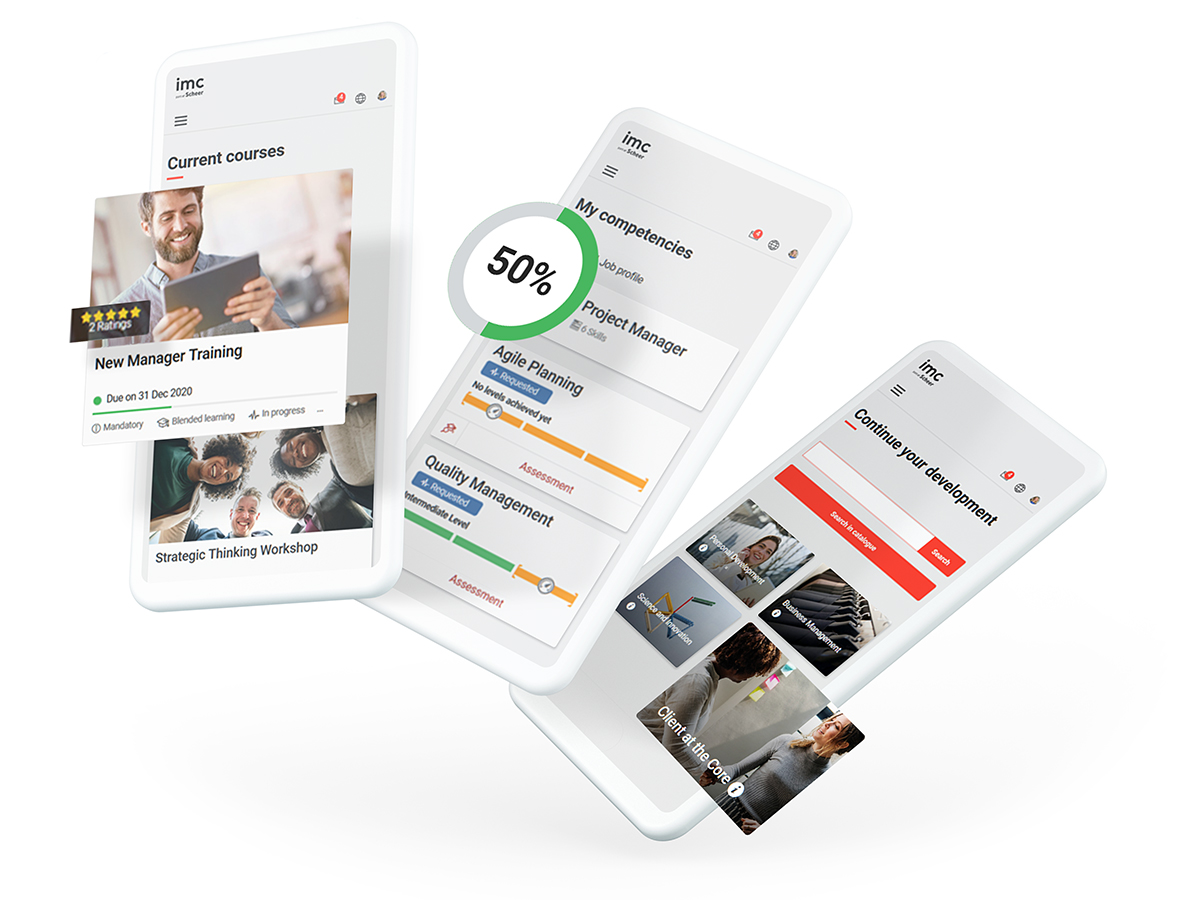
More about our LMS
If you would like to learn more about imc's Learning Management, check here for more information.

Contact person
I have been working in the Marketing & Communication Team at imc since March 2019.
Communication, creative content and social media are my passion. "KISS - Keep it short and simple" is my credo.
To explain complex content in an understandable way and thus make the topic of e-Learning accessible to everyone is an exciting challenge every day.
Privately I love to read, play poker and travel a lot.
I am always happy to receive feedback or suggestions.

corporate learning
10 proven ways to keep corporate learning engaging
Rolling out certain types of learning content can sometimes cause L&D or IT managers to cringe. This is especially likely when technical content focuses on dry subject matter or tick-box compliance exercises that aren't always directly related to the learner's role.

Top 10 tips for HR heads, IT security, and L&D professionals to foster active learning
Technical training topics, such as cybersecurity awareness training or learning a new software system, are often essential for employees to acquire the necessary skills and knowledge to be productive or to comply with legal/regulatory requirements. However, these topics are often considered dry and boring due to complexity, specialised language, or seemingly distant relevance to everyday work life.
The 10 ways to keep corporate learning engaging set out below make the learning process more enjoyable and effective.
1. Relate to real-life scenarios
Learners are more likely to engage with technical topics if they can see the direct relevance to their lives or careers. Present real-life scenarios, case studies, or anecdotes that demonstrate how the technical concepts are applied in practice. This will help learners understand the importance of mastering these topics and make the material more relatable.
2. Break down complex concepts
Technical topics can be intimidating due to their complexity. Break down the concepts into smaller, digestible parts, and provide clear explanations and examples for each. Use analogies, metaphors, or comparisons that learners can easily understand to explain difficult concepts. Additionally, create a logical progression of information, building on what learners have already grasped.
3. Use multimedia resources
Leverage various multimedia resources, such as videos, audio recordings, graphics, and animations, to illustrate technical concepts. These resources can help make the material more engaging and accessible, as well as cater to different learning styles. Additionally, incorporating multimedia resources can reinforce key concepts and provide alternative ways for learners to process information.
4. Encourage active learning
Active learning techniques, such as group discussions, problem-solving exercises, and hands-on activities, can make technical training more engaging. By actively participating in the learning process, learners can better internalise and retain the material. Encourage learners to ask questions, share their perspectives, and collaborate on projects to create a more interactive learning environment.
5. Gamify the learning experience
Gamification can make dry technical training topics more enjoyable and motivating. Introduce game elements, such as point systems, leaderboards, and badges, to create a competitive atmosphere and drive engagement. Additionally, design interactive quizzes, puzzles, or simulations that require learners to apply their knowledge in a fun and challenging way. As an example, we turned one of the driest topics of all - cybersecurity training - into a fun, interactive game - Cyber Crime Time.

In this gamified learning experience, you take the role of a devious hacker. By exploring IT security from the hacker's perspective, learners gain new levels of cybercrime awareness without the process feeling like 'training'.
Try out the game for free to learn about this innovative approach to technical training.
6. Provide immediate feedback
Timely feedback is crucial for learners to understand their progress and identify areas for improvement. Provide immediate feedback during training sessions, either through automated systems or personal interaction. This will help learners adjust their learning strategies and stay motivated.
7. Foster a supportive learning environment
A supportive learning environment can help learners feel comfortable asking questions and discussing technical topics. Encourage open communication and create a culture of mutual respect and understanding. Instructors should be approachable, patient, and willing to provide assistance as needed.
8. Set clear goals and expectations
Learners are more likely to engage with technical training if they understand the goals and expectations. Clearly communicate the learning objectives, expectations, and assessment criteria at the beginning of the training. This will help learners focus on the most important aspects of the material and track their progress.
9. Offer flexibility and customisation
Allow learners to customise their learning experience based on their needs, interests, and learning styles. Offer flexible pacing, optional supplementary materials, and various learning pathways to accommodate individual preferences. This will help learners feel more in control of their learning experience and increase their motivation to engage with the material.
10. Incorporate peer-to-peer knowledge sharing
While some technical training will often need to be formally structured to ensure precision or regulatory compliance, there is often space for informal, peer-to-peer knowledge sharing.
Does your new software system have a 'power user' in the company? Or does one of your team have a way of communicating and sharing knowledge that’s particularly funny or engaging.
Some new e-learning authoring tools, like our own imc Express, are emerging that make it quick and easy to create and share multimedia learning nuggets in as little as 10 minutes. This can enable subject matter experts to become a useful addition to the L&D team - albeit unofficially. It also helps to avoid valuable knowledge and experience to be siloed within departments - or even worse, lost altogether if key personnel were to leave the company.
How to get started
Engaging learners with dry technical training topics may be challenging, but it is achievable if you implement some or all of the above 10 ways to keep corporate learning engaging. By relating the material to real-life scenarios, breaking down complex concepts, using multimedia resources, and fostering active learning, L&D or IT leaders can create a more engaging and effective learning experience for their learners.
With the right approach, even the driest technical topics can become engaging - maybe even fun! 🙂
Want to learn more about tools and strategies to make technical training more engaging and effective? Get in touch - we'd love to hear from you!

When an Awareness Week Is Not Enough – Engaged Learning Through Learning Campaigns
Using learning campaign portals to create immersive learning campaigns
Some things just can’t be learned in an hour. Or even a week. Things like organisational change management – where attention needs to be focused on a specific topic over a prolonged period. In these cases, sustained learning is key.
It’s a little bit like classic advertising. Coca-Cola’s annual advertising presence, for example, doesn’t hinge on a single one-week TV spot campaign. Instead, the company draws attention to its products over a sustained period using a strong, well-coordinated multi-channel campaign. It’s all carefully designed to ensure consumers reach for the red can the next time they open the chiller.
In the same way, a good learning campaign should bring about a mind shift – ideally one that leads to concrete action. Sounds good, but how exactly? The answer is portals. They can provide a highly effective entry point to learning campaigns. In this article, we outline the structure and use of learning campaign portals.

Immersive user interfaces for specific topics
With organisation-wide learning and development (L&D) campaigns, the idea is to reach as many employees as possible. And for that, the content must be both learner-centric and accessible without any time or location constraints. Most importantly, it must boost learning motivation and generate successful, lasting learning outcomes.
These objectives can be achieved by using a learning campaign portal. Learning campaign portals are add-ons for learning management systems. They facilitate orientation in complex learning campaigns, providing learning environments that are so immersive, learners don’t even realise they’re learning.

These interactive learning environments are custom developed for each client and brand. Learners can make their own way through the navigation structure and access different items of learning content through jump labels. The result is a digital journey of discovery that is almost limitless in scope. Chatbots, avatars, and dynamic environmental and special-effect sounds can be integrated to reinforce sustained learning effectiveness. Similarly, gamification elements can be added to further enhance learner motivation.
Some applications of learning campaign portals
- Change campaigns: Change campaigns are a way of making lasting change to employee mindsets and corporate culture. The objective is to boost acceptance through learning. That way, employees are more amenable to the proposed changes and more willing to contribute to their success.
- Events: Many organisations use action days to raise employee awareness of certain issues and communicate the organisation’s position on those issues.
- Onboarding and upskilling: Effective onboarding gets new employees off to a good start with the company. It also creates a sense of belonging and instils an understanding of the company’s values and culture.
- Comprehensive learning journeys: Learning journeys put the learner first and offer different learning formats for different topics and learning objectives.

Gaming meets navigation system
The heart of a learning campaign portal is a 2D or 3D map. Alongside its orientation function, the map draws the learner into a fun, game-like journey of discovery. This gamification element is designed to appeal to the young and youthful. However, a good learning campaign portal will be readily accessible for learners of all backgrounds thanks to its intuitive navigation system and quality orientation features.
Example: A company wants to run a six-month sustainability and environmental campaign. The aim is to explain the company’s own position, raise employee awareness, and bring about a mind shift. In this example, the company could integrate a portal upstream of its LMS that guides employees through all learning content relevant to environmental protection.
There are no design limits to how this might be achieved. In the above example, the map through which learners journey could be a rainforest or ocean, for instance. Or perhaps the company wants to present a future vision of its own site or visualise the campaign by means of a custom campus. This level of creative freedom calls for good sparring partners who, for all their love of the product, are always mindful of functionality. This is where our experts come in. They provide comprehensive advice on all aspects and put successful learning front and centre.

The facts:
- Learning campaign portals are not ad hoc solutions – they require a planning and development phase.
- The scope of learning campaigns should be limited either to specific content or specific timeframes.
- A learning campaign portal is not a stand-alone product – it requires a learning system (LMS).
- Independent exploration of a map will enhance motivation.

Development Paths: Moving Beyond Learning Paths
Learning paths have been part of corporate learning for a while, but they’re not being used to their full potential. Learning paths offer more than just a way of providing short-term training for employees; they can be an absolute game changer in the fight to overcome skills shortages.

How Tinder and Netflix are shaping the future of learning
In a challenging environment, corporate learning will remain effective only if it is learner-centric and offers formats that are in keeping with learners’ other everyday digital experiences. This is important because learning providers are no longer competing just with other learning providers; they are also competing with dating apps, streaming services and social media.

Contact person
I joined the imc newsroom team in 2021. As a journalist my heart beats for content and storytelling.
I’m excited to figure out how e-learing and digitization affect the future of work. My task is to create content to talk about and I’m always looking for trends.
Privately I love to travel and eat Tapas.
Topics: E-Learning Trends, Corporate Social Responsibility, Press and Influencer Relations

How Tinder and Netflix are shaping the future of learning
The media consumption patterns of Gen Zers call for completely new learning formats – Here’s one we’ve come up with
The media consumption habits of people currently moving into the corporate workforce are very different to those of previous generations. And they are playing a major role in shaping employee expectations around work and professional development. In this challenging environment, corporate learning will remain effective only if it is learner-centric and offers formats that are in keeping with learners’ other everyday digital experiences. This is important because learning providers are no longer competing just with other learning providers; they are also competing with dating apps, streaming services and social media.
One key way of staying competitive in this sense is to develop individualised learning experiences and adaptive learning content. And we have a new tool that can help with that. Introducing the “Readiness Check”.

“We want to be the Tinder or Netflix of learning”
Gen Z has integrated digitalisation into all aspects of daily life, as Dr Robert Lohmann, product manager for learning content at imc, knows full well. “These days, you’re not going to get engagement from anyone by throwing content at them in the form of outmoded training courses,” he says. “These sorts of courses were all well and good at the time, but now they are no longer enough. And that’s why we’re increasingly working with elements and features that are familiar from other digital domains, such as chat bots, swiping in dating aps, and content recommendations of the kind used by streaming services.”
Companies, including their learners, want customisation, but they don’t want to pay the earth for it. Hence the growing demand for off-the-shelf learning content.
But even with off-the shelf content, adaptive learning and individualised learning experiences are an absolute must if you want to engage with the new generation of learners. “That was the big challenge here: to create off-the-shelf training content that is generic enough to be useful to a wide range of users while still offering individualised learning,” Lohmann explains. “And that’s what we achieved with our Readiness Check in the case of our awareness game Cyber Crime Time.”
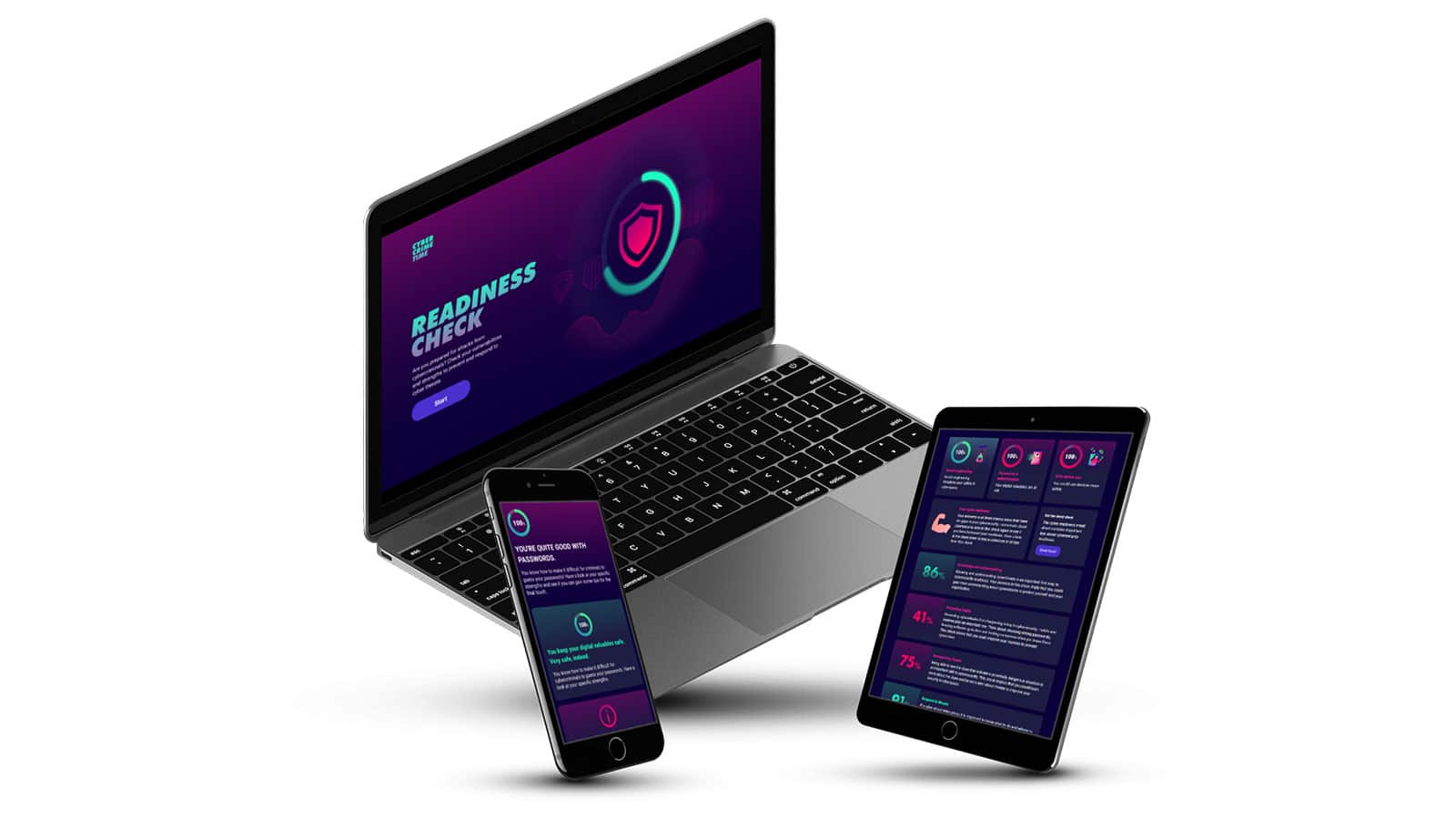
Using the Readiness Check to make learning experiences more customised
The Readiness Check enables companies to build up a highly granular picture of their learners’ current level of knowledge so they can tailor an appropriate response. In all likelihood no two users will ever receive exactly the same feedback when working with the Readiness Check. So, how does it work?
Timo Paul, a senior frontend developer in our content department who played a major role in developing the Readiness Check, explains: “It works by assigning a numeric value to each of various defined learning categories. The numeric values themselves are variable, so they can be specific to the learner. The response yielded by the Check is thus highly customised and can comprise anything from simple feedback to activity or content recommendations all the way through to further training courses or learning nuggets. There are no limitations, and that’s what makes this tool an attractive option for creating customised learning experiences.”
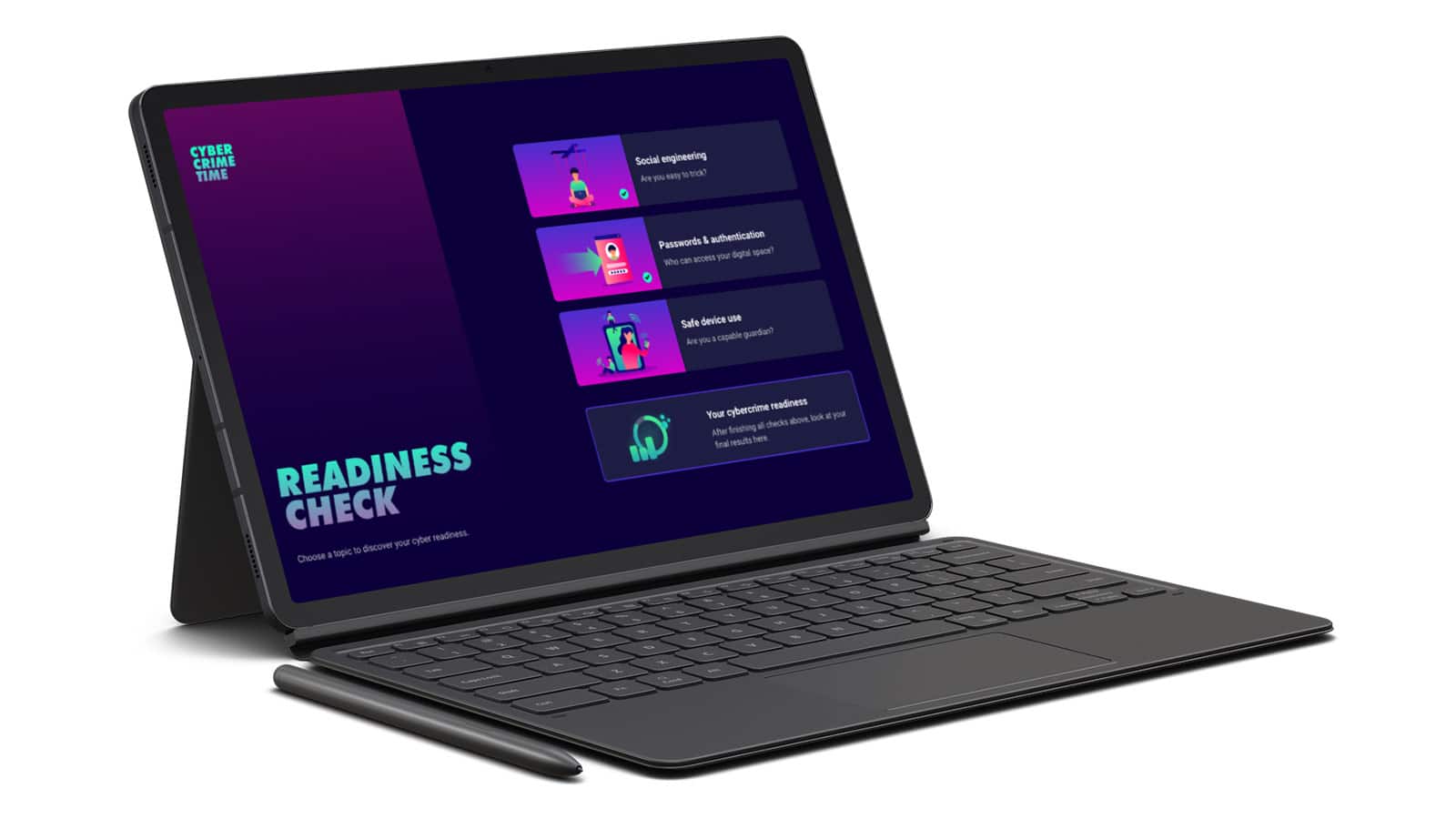
The tool can even be used with very broad learning domains simply by aggregating multiple Readiness Checks into one overall Check, as Timo Paul explains: “It’s a bit like a general knowledge quiz, where you poll the subject’s knowledge in multiple categories and hence arrive at an individual result for each category. The technology behind the system then compiles the results of the individual categories to arrive at an assessment of the subject’s general knowledge.”
It’s all in the weightings
By now, some of you have probably concluded that the Readiness Check uses some form of AI. And you’d be wrong. It uses something even better than AI: humans. The people who configure the Check specify the weightings that lead to the final result. In other words, they determine the numeric values of the individual answers or categories within the Readiness Check, which enables them to make a qualitative assessment of the learner’s existing knowledge.
The overall result is not based solely on the number of correct answers, but also on the weightings that have been assigned in the background. “That’s what’s new about the Check,” Timo Paul explains. “We supply the tool, and then the person responsible for training content works with us to set the tool up so that it meets their needs.”

Cost savings through individualised assignment of learning content
Last year, imc wowed the market with its award-winning “Cyber Crime Time” cyber security awareness game. So, it made sense for the company to integrate this new learning format into its own in-house premium training. And it did this using the Readiness Check. “The development work we did for the Cyber Crime Time Readiness Check was a valuable learning experience for us,” Dr Lohmann says. “It involved developing something in-house and then testing it over and over until we were happy with the result. And that result is the Readiness Check. It’s been a big help for us, and our clients can now benefit from it too. A lot of blood, sweat, tears and time has gone into getting this tool just right, and now it’s ready to go.”

Ready to go!
But the two categories can also be combined to leverage their strengths, Härle explains: “There really are no limits! With an individual learning journey, off-the-shelf content might, for example, be included as learning nuggets. Our objective is to create off-the-shelf content that feels nothing like off-the-shelf. Cyber Crime Time, the Journey, is a prime example for this.”

The Netflix Factor in Self-Directed Learning
Self-directed learning and Netflix have a few things in common! We find out what, how it can be used in companies and where the limitations lie in corporate learning.

Off-the-shelf content has come a long way from being an uncomfortable compromise
Costum or off-the-shelf training content - which should you choose? You should first ask yourself: Is the training need or problem I have very specific? Or is it something that many different people in different industries need training on?

Contact person
I joined the imc newsroom team in 2021. As a journalist my heart beats for content and storytelling.
I’m excited to figure out how e-learing and digitization affect the future of work. My task is to create content to talk about and I’m always looking for trends.
Privately I love to travel and eat Tapas.
Topics: E-Learning Trends, Corporate Social Responsibility, Press and Influencer Relations
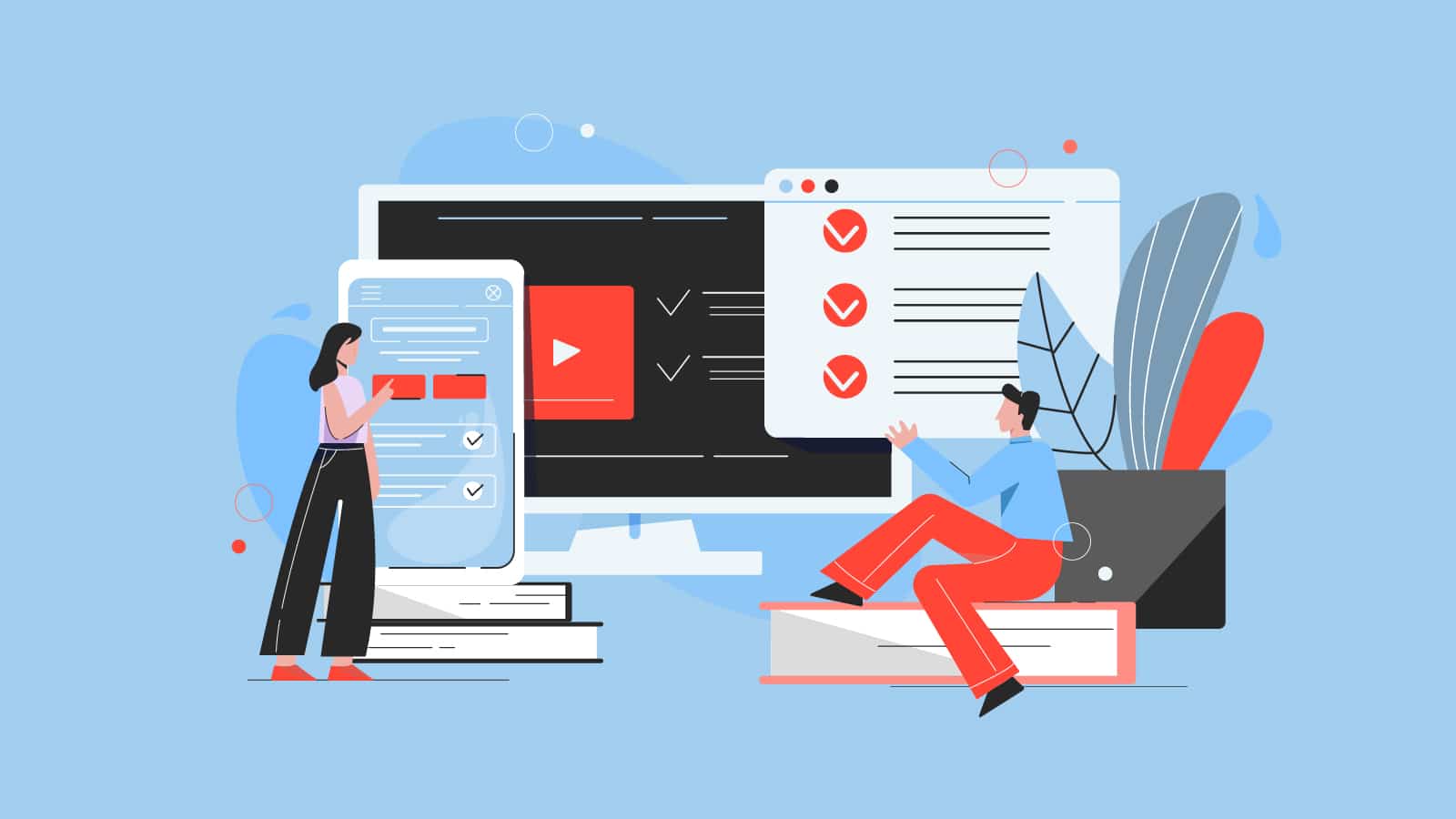
Creating the Perfect Learning Experience for a Remote or Hybrid Workforce
Times have changed for L&D - while many large organisations were already putting resources into digital transformation, our workforce is now more dispersed, with hybrid and remote working looking like it’s here to stay even post-Covid.
Alongside these trends, we have ubiquitous access to more information through ever-faster Internet and mobile devices, while top talent expect to be supported in their professional development - otherwise, they will move on.
What remains the same are people and their motivations. People are fundamental to any company, and what drives a company forward and helps it to stay afloat in a competitive market is an engaged, well-informed and adaptable workforce.
Here we look at how to facilitate the personal and professional development of top talent by creating the perfect learning experience for a remote or hybrid workforce, so that training can become a key competitive advantage.

Technology and a Learning Ecosystem
Keeping your workforce at the forefront of your industry requires regular formal training, but also informal and rapid knowledge sharing between employees and departments.
The ability to respond quickly to new products, services, industry guidance and competitive environments through learning will give any company a competitive edge, but this can be diminished when working remotely.
Whether we’re training face-to-face, digitally or virtually, the fundamentals have remained the same for a very long time; we’re socially motivated learners who need context, reinforcement and practice to acquire new skills. We don’t respond well to formless, monotone, poorly presented content, and we don’t retain information as effectively when we’re not engaged. Making your learning journey engaging, enticing and efficient is where technology can come in.
Technology has revolutionised how we design and deliver learning experiences. Today, learners expect a digital training experience that’s accessible, flexible and engaging.
They’re used to platforms such as Netflix that neatly package and categorise content for them, and offer a library and playlists with a user-friendly interface.

There are a wide variety of digital and online tools that can help learners have a positive learning experience. These are especially useful when it comes to mandatory training, such as for legal or industry compliance, which employees know they need to undertake but may not necessarily be enthusiastic about.
It doesn’t matter how engaging and talented your experts may be, if the platforms and tools you’re using to host a learning journey aren’t up to scratch then your learner will find it difficult to focus.
When seamlessly integrated, there are 3 key L&D tools that can help you create the perfect learning experience even when your teams are disparate. These are the LMS, LXP, and rapid content authoring tools - let’s examine each in turn.
What is a Learning Management System?
A Learning Management System (LMS) maintains, tracks and records a learner's journey, including analysing their comprehension of subject matter and completion of learning events. An LMS will help L&D managers track an individual's or a group’s progress through training by serving as a system of record and audit, and pinpointing where they may need additional help or support.
There are several types of Learning Management System which meet various needs and budgets, including open source software, deployed or Software as a Service (SaaS) solutions. An open source solution is free at the point of access and has a committed online community that will update it regularly, rolling out improvements and add-ons for all to use. It can be a good option for companies with tight budgets who desire something to enhance their learning experience without breaking the bank. However, it can be a security risk without expert set-up and support, and can often be plain and uninspiring out of the box, requiring a great deal of design and customisation - all of which comes at a cost of course.
A hosted or Software as a Service (SaaS) system runs on someone else's server, is set up by a provider and may offer a more customised solution compared to open source software. These systems are usually quite ready to use out of the box.
A deployed LMS solution is set up on computers within your premises, which has its pros and cons. There are greater up-front costs to install the LMS software on-site, but it may save you more money in the long run. This might be a good choice in highly regulated industries and when you have the in-house technical expertise to maintain it.
Historically, the LMS can be unintuitive, unattractive and complex for the user, making it difficult to navigate and read or watch the learning content. In some cases, a badly designed LMS can create more of a hurdle to learning than the content itself.

The best LMS, such as what can be found within imc’s Learning Suite, create an easy to use learning journey though, so that learning can be an engaging activity rather than a chore.
An LMS is often seen as a solution for top-down training mandated (or at least encouraged by) the employer. It’s not really designed for self-motivated learners to explore new learning opportunities. This is where a Learning Experience Platform can come in…
What is a Learning Experience Platform?
A Learning Experience Platform (LXP) is the Netflix of the learning technology world. A quality learning experience is designed to entice, encourage and excite learners to consume the content. It’s for self-motivated learning to develop their personal and professional knowledge and skills, which in turn will usually bear fruit for the employer too.
The LXP is designed to be more intuitive to use than the LMS, and utilised effectively, it should provide contextualised, relevant and custom content from multiple sources in order to cater for different learning styles and preferences.
It’s a diverse learning ecosystem of multimedia content exploration.
LXPs enable you to create a personalised experience that can curate and recommend the best content for each person.
We were talking earlier about how hard it can be to motivate people to undertake essential, mandatory training, such as compliance. Well, an expertly executed LXP should make learning feel fun and easy for your learner, yes really - fun, and in turn, hopefully, it will help employees to feel supported and valued, and help to create a culture of learning within an organisation.
Think of the difference between using Netflix or scrolling a government site, what one would you prefer to use? The more at ease and enthused your learners feel in their learning environment the better their journey will be.
The imc Learning Suite combines the best of both an LMS and LXP - giving L&D teams what they need to deliver and track training, and giving employees a place to explore learning opportunities for personal and professional development.
What are rapid content authoring tools and how can they help me create quality training content?
Rapid content authoring tools are a form of software that enables experts to create and package learning content using various forms of media. It means your experts or training managers can create new content, make changes and send updates to learners quickly and easily. The working landscape is ever evolving, especially in post-covid times with hybrid working becoming the norm, and tools such as rapid content authoring empower companies to respond swiftly to changes and stay relevant.
Adopting content authoring tools can enhance your digital transformation journey as a company, empowering experts and learning and development professionals to create adaptive engaging content promptly.
Rapid content authoring tools can help you:
- Repurpose existing content quickly
- Keep development costs low
- Respond swiftly to new products, services, market or environmental changes
- Update and upscale content quickly
- Deliver knowledge in easy-to-digest chunks
- Share content with learners on any device
Content-authoring tools include software Articulate Storyline, Adobe Captivate, Lectora and Camtasia. However, you might have in-house subject matter experts willing and ready to create and share their experience and expertise if they can avoid the learning curve of software used by professional instructional designers.
imc Express enables the quick creation of elearning materials that are rich, engaging and multimedia, but without that learning curve.

What is a healthy learning ecosystem?
A learning ecosystem comprises the elements that make up your user's learning journey and environment including the tools, platforms and technologies. Just like the natural ecosystem, the more diverse the learning environment, the more effective the learning will be.
A complete, well-integrated Learning Suite can enhance not only your learners' experience but your subject matter experts' effectiveness too, enabling them to build engaging content and communicate quickly and efficiently to drive knowledge sharing.

A complete learning experience
Technology helps learners have a positive learning experience, especially when it comes to compulsory training where they may lack the motivation to complete.
Learners today expect training to be engaging, entertaining and diverse in format. This is especially true as remote and hybrid working is on the rise and our workforce becomes more distributed.
People are looking for social connection, a platform that is instinctive to use and easy to digest content that they can absorb and experience digitally or virtually. The latest and best in learning technology can help us achieve all of this.
Want to learn more about leveraging the latest technology to create the perfect learning experience for a remote or hybrid workforce? Contact us here at imc Learning.

Turning a learning curve into an earning curve
Set online training up for success in such an extended enterprise learning scenario, and how to turn a learning curve into an earning curve.

Learning Management System for Membership Organisations
Make your platform effective for current and future training needs for your membership organisation.

Examples of a Good Learning Experience
Here we offer examples of a good learning experience from a handful of our projects.
It’s always a shame when training is rolled out without due consideration for learner engagement. This is one of the reasons that e-learning has a bad reputation - it’s too often seen as a ‘Click next’, box-ticking exercise that employees want to get through ASAP then get on with their day.
High quality, engaging e-learning helps to ensure that learners absorb, retain and implement new knowledge and skills, bringing about long-term behaviour change and improved performance.
Delivering a good learning experience can also help to create a culture of learning where employees then go seeking out personal and professional development opportunities that will benefit the whole organisation.
So on to some examples of where our e-learning solutions, including custom content and learning management systems (LMS), have enabled training to deliver real impact…

Not just good – a Meisterpiece: LMS and blended learning for Jägermeister
Jägermeister has around 1000 direct employees, plus a large network of resellers and external distribution partners around the world, making a large number of people requiring training.
At the same time, a coherent and strong brand image that all employees identify with is a top priority for Jägermeister, so the learner experience was considered crucial.
They decided to use the imc Learning Suite for their training platform because the well thought out extended enterprise scenario, in combination with the clear module structure, convinced them that we were a good fit for their needs.

Following testing and roll-out, users were especially taken with how the e-learning content triggered an emotional response. The consensus among the employees: Once you log in to Meister Academy, the training courses don’t feel like learning.
The direct integration of LinkedIn Learning courses was also received very favourably, as it gives employees an even greater choice of courses.
Philipp Terstesse, Manager Global Trade Marketing at Jägermeister, gave the following summary:
“Our goal was to create a learning experience that takes a new approach and motivates learners. The learner and employee experience were extremely important to us.
We firmly believe that our digital ambitions go a long way towards shaping the future of our brand. We are thrilled to have a strong partner in imc who will stay by our side as we embark on this journey into the future together.”
Read more about our work creating an LMS and blended learning for Jägermeister.
Comprehensive onboarding and learning experience for The Green Climate Fund
Established within the framework of the United Nations Framework Convention on Climate Change (UNFCCC), this organisation based in South Korea was set up to assist developing countries in adaptation and mitigation practices to counter climate change.
At the time of writing, The Green Climate Fund (GSF) had raised $10.8B USD to support 200 projects and avoid 2.1B tonnes of CO2 pollution.
The fund wanted a comprehensive onboarding and training solution providing an understanding of GCF's climate focus, shared values, governance, policies and practices, all underpinned by a learning experience framework and strategy.

We worked closely with GSF to create their Learning Experience Framework - a continuous model of learning and development that embeds opportunities of meaningful experience, exposure and education.
This was followed by 20 hours of Digital Orientation Modules, focusing on four core types of digital learning approaches to meet the diversity of needs we discovered throughout our research:
- Scenario-based training
- Storytelling
- Problem-based learning
- FAQs and resources
As a result of this e-learning, we were able to measure a reduction in human operational and procedural error, while embedding confidence and competence among new employees.
imc and the Green Climate Fund were recognised as Platinum winners in the 2021 LearnX awards. Client feedback was also extremely positive - George Zedginidze, Head of Knowledge and Change Management at the Green Climate Fund said:
“We at the GCF are elated to be partnered with imc! Their professionalism and flexibility has made this project what it is today. We are especially thrilled with the imc team, whose time, effort, and abilities have made this partnership a success.”
Read more about this onboarding and learning experience project for GCF.
Motivation for an unloved topic: compliance training for Audi
Trainees are usually unenthusiastic about the idea of compliance training even before it begins - to say the least. So Audi wanted to create unusual compliance training, delivered in a way where the necessary knowledge is clearly conveyed to them and they have fun along the way.

“Welcome to Fraud City. The city “eats” its residents – skin, hair and all. We hope you’re up to it. Enter at your own risk.”
Not your usual intro to compliance training! This entire web-based training (WBT) course involved motion design and adopted the style of “Sin City”. It takes the brave participant to a corrupt city full of dangers and suspect colleagues – accompanied by Detective Fraudless.
The employee navigates through the training course with the criteria for identifying cases of fraud being revealed along the way. So are behavioural patterns that call for special attention.
Audi demonstrated great courage with this unconventional concept – and reaped the rewards: The elaborate and polarising concept leaves a lasting impression, creating a buzz among almost all employees.
Laura Schumacher of the Audi Compliance Department told us:
“Compliance training is always a tricky subject. For this WBT though, we received very favourable feedback from our employees!”
Read more about this fun and engaging compliance training for Audi.
Want to learn more?
You can see more examples of a good learning experience within the case study section of our website. Can we help you to transform training within your organisation by creating an engaging learner experience?
Contact us here at imc.
![[E-Learning Punk] Exploratory 3D Learning](https://imc.zeitraum.com/wp-content/uploads/2021/02/imc_image_elearningpunk_3Dlearning_hero.jpg)
Exploratory 3D Learning
Not only movies like “Avatar”, but also learning content can benefit from spatially compelling images. We explain the advantages of this professional development trend and present you application scenarios for 3D learning.

Immersive Learning during the Crisis
Immersion is one of the most successful learning methods. Jennifer Fritz, VR expert, points out the potential benefits of using Virtual Reality especially during this unprecedented times.
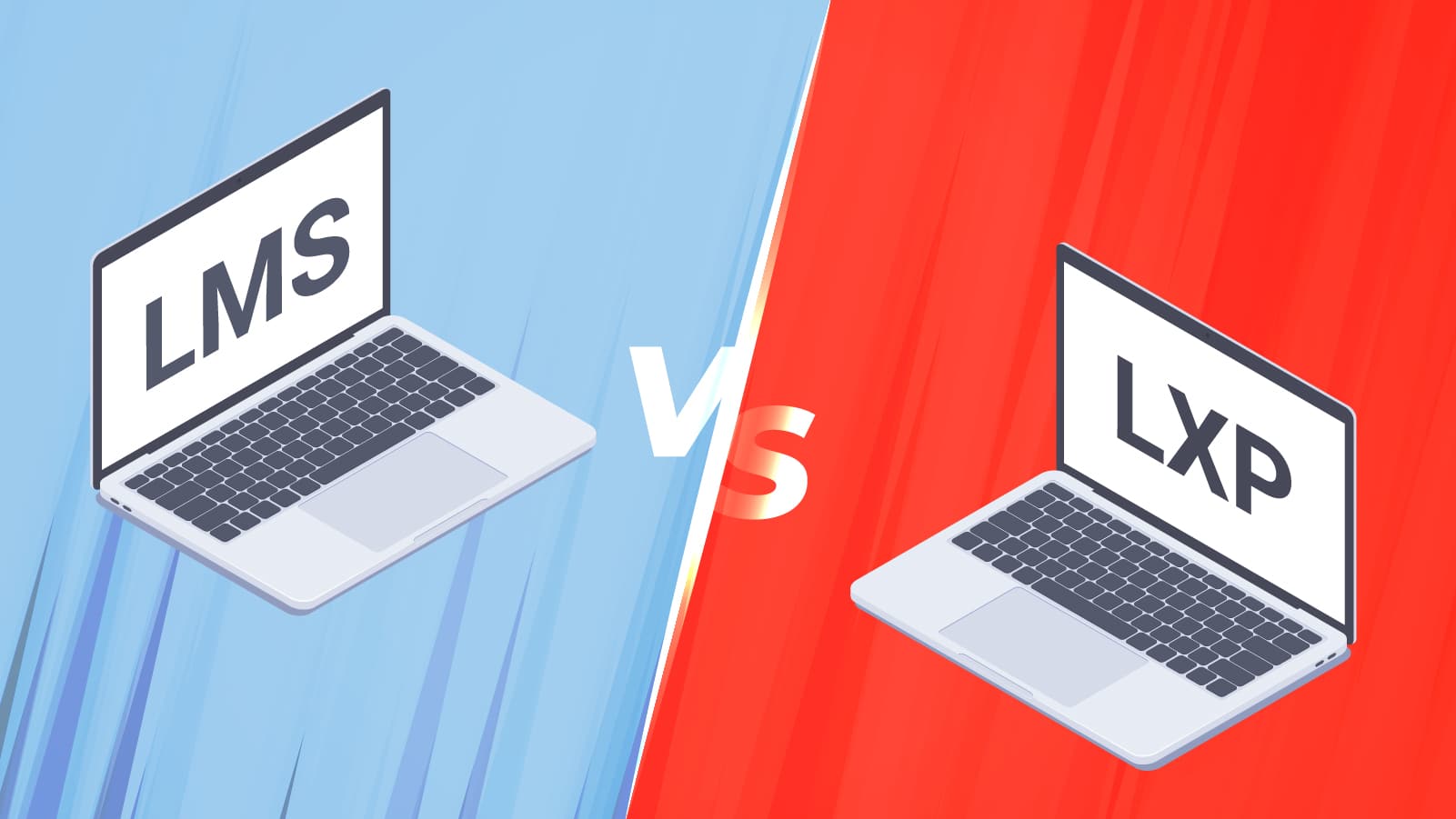
LMS vs LXP - What's the Difference?
If you are weighing up the pros and cons of an LMS vs LXP or even an integrated solution in a Learning Suite, here we offer an introduction to these concepts.
So what’s the difference between a learning management system (LMS) and a Learning Experience Platform (LXP)? It’s all about push vs pull.

What is an LMS?
An LMS is a tool for Learning and Development (L&D) managers, and often HR teams, to roll out training and make it available via desktop or mobile devices. It can enable anytime, anywhere learning if learners can access e-learning content online.
The LMS is most commonly used for employee onboarding and compliance training, getting new hires up to speed with health and safety, company procedures, product knowledge, and ongoing training that will support the organisation towards its goals.
Because this is very much top-down, it’s the Push side of training and is often mandatory as dictated by the company and managers, and perhaps also by law or industry regulators.
The benefits of an LMS include:
- The ability of L&D and HR to roll out training content quickly at scale - even to a global workforce
- A low cost way to update existing training materials when products, services or legislation change
- The ability to demonstrate completion of mandatory training, assisting regulatory compliance
- Learner analytics, which will help to identify individuals or groups need additional support.

What is an LXP?
The LXP is a relatively new concept that puts the focus on the learner and their wants in terms of education and training. It enables the exploration of optional learning content away from anything related to mandatory training.
The LXP takes into account the fact that different people have different personal and professional goals, with some people actively seeking out new learning opportunities beyond those specified as being essential by the employer.
AI and recommendation engines might be used to suggest e-learning content that might be of interest to each individual based on their current role and potential career path and / or their previous learning behaviour. This is similar to how Netflix will suggest TV shows or movies to watch next based on previous viewing behaviours.
Suggested content could be within the LXP itself or hosted externally, such as YouTube videos.
As the employee is in control of the pace and content of their learning, it is bottom-up and is the Pull side of training - suggested and encouraged, but never mandated.
The benefits of an LXP include:
- Making the employee feel valued and supported as an individual, creating a positive learner experience
- Creating a way for highly motivated employees to better their knowledge and skills, which in turn can benefit the company because talent can flourish
- Increased employee retention - the LinkedIn Workforce Learning Report of 2022 showed that with better internal mobility support, companies see an average tenure of 5.4 years - nearly double the 2.9 years found at companies that struggle with it
- Support for the broader digital learning transformation journey - as learner-initiated training will be more enjoyable, it helps the entire organisation become more engaged with e-learning as the primary way of enhancing knowledge and skills. This not only creates a culture of learning, but can add rocket fuel to the long-term digital transformation programme.

LMS, LXP or Learning Suite?
So with so many important attributes within both the LMS and LXP, do you need both? Many organisations do successfully manage two systems with some integration with HR and people management tools, but this can lead to some inefficiency and additional administration time.
The easier and more efficient way to leverage the benefits of an LMS and LXP is to have a single, integrated solution in a Learning Suite.
This modern solution allows L&D and HR teams to collaborate without duplication of effort and administration time, and allows the learner to seamlessly progress from mandatory training to optional learning for personal and professional development.
If you’re looking to create a culture of learning within your organisation to increase employee satisfaction and improve performance, as well as potentially accelerating digital transformation, a Learning Suite is certainly the way to go.
The imc Learning Suite is a modern platform based on decades of experience supporting training at some of the world’s best known brands. It’s highly customisable and brandable, and supports every type of training, from Compliance to AI-supported, Personalised Learning paths.
Because it easily integrates with existing people management and business software, it can slot in with existing technologies - minimising additional admin time to start leveraging its benefits.


The Dawn of Integrated Platforms
Setting up an entire learning ecosystem through the structure, connection via API & Artificial Intelligence are some considerations when integrating an LMS & LXP.

Headless LMS - definitely not brainless
A headless LMS makes data maintenance significantly easier while also facilitating greater flexibility and customisation, especially within a learning ecosystem comprising several systems in communication with each other.

Using Improvisational Theatre for Corporate Learning
Interview with Marlene Konrad, a consultant and trainer specialising in communication, collaboration and change
The curtain is just about to go up. The actors are calming their nerves as the excitement in the audience builds. Just another “normal” day at the theatre. Except there’s no script: anything goes. This is improvisational theatre, and spontaneity is the name of the game.
Improv actors need to be constantly on their toes, ready to pivot and respond to ever-evolving situations. Working together, they juggle ideas, developing the scene as they go along. If one idea falls flat, they move on to a new one without any break in the flow of action.
The skills used by improv actors seem to align closely with what’s expected of a lot of teams in today’s corporate world. In both cases, it’s about navigating uncertainty, constantly adapting to new challenges, trusting in one’s teammates, and working together spontaneously.
If this is true, then surely it’s not too much of a stretch to use improvisational theatre techniques in corporate learning? To find out how this might work, we spoke to Marlene Konrad, a consultant and trainer specialising in communication, collaboration and change.

Change requires a willingness to learn
“For me, learning and change are two inseparable parts of the same thing,” Marlene Konrad explains. “Change in an organisation can succeed only if all employees learn something new and if they learn how to grow and develop. That’s why learning is such a key part of my work.”
Konrad studied theatre and media studies and English language and literature. She completed her practical training at Commha Consulting, where she continues to work as a consultant and trainer.

Marlene Konrad
In her work, Konrad likes to switch things up and try out-of-the ordinary approaches. She is passionate about improv theatre, for example. “Using improvisational theatre, or at least elements of it, as a training method is nothing new. It’s called applied improvisation, and it’s been around for quite a while. But I’ve developed my own personal approach because I’ve been doing improvisational theatre for a long time and have led several improv groups.” Alongside a whole range of improv-inspired projects, Konrad uses improvisational theatre techniques in two main areas.
Agile teams
The salient point here is that improvisational theatre is a team sport. “Improv theatre teams have many characteristics and skills in common with effective teams in work contexts. Hence, we can adapt a lot of improv techniques for team development and collaboration. Improv teams have to remain unfazed by extreme situations. They need to be able to navigate complete uncertainty, for example. And that’s also something that is expected of agile teams in work contexts.”
Reflection
Another key aspect of improv theatre is that it sheds light on things that would otherwise remain hidden: “Improvisation makes intangible things real. That’s why I like to use it as a tool for reflection. Improvised roleplays bring into the open things that are normally difficult to explore, such as communication, conflict, feelings and interpersonal relationships. This is hugely important in feedback training and leadership seminars, for example.”

New Work – new challenges: Tomorrow’s teams need more certainty
For Marlene Konrad, one of the greatest challenges in organisational transformation processes is to embrace flexible thinking. She explains this in terms of companies weaning themselves off rigid processes and workflows while still ensuring that their employees feel safe and secure. “Perhaps you’ve heard of ‘psychological safety’. This is where I foster in a team a sense of safety that comes from the team itself, from the interrelationships and responsibilities between the members of the team,” Konrad explains. “It’s important that this feeling of safety no longer derives from processes because processes can quickly change. So, as well as being flexible, the team needs to work on relationship building.”
Improving this sense of safety within teams is another area where improv theatre techniques can help. To be able to function as a member of an improv team, you have to be open to what’s going on around you and willing to put yourself out there as a person. “You’re thrown into a situation where you need to swing into action quickly because there’s no time to think about ‘what if’. In that situation, you need to have the confidence that you won’t make a fool of yourself if you react spontaneously. That it’s okay to mess up and fail. The art is to ‘fail well’. And that’s something that can be practised using improvisation methods.”

The “Yes, and...” thinking as an innovation booster
Ever been in a meeting and heard an idea dismissed with “yes, but...”? How might that meeting have gone differently if everyone had said, “yes, and...” and simply taken the idea and run with it?
“Yes, and ....” thinking is a key part of improv theatre, and it’s a highly effective technique in innovation processes, as Konrad knows from personal experience: “By saying ‘yes’, I start by accepting what my conversation partner is saying. I consciously avoid following that with ‘but’ because a ‘but’ can close the door to a lot of potentially good ideas. You need to keep that door open and start out by saying yes to everything. Spontaneous improvisation is a good way of explaining this principle.”
Of course, after all those yeses, the team needs to make an intelligent selection and close the meeting. “That’s another aspect that improvisational theatre is great at teaching,” Konrad explains. “When doing a scene, if you keep bouncing from idea to idea to idea, then sooner or later the audience will get bored. Hence the actors need to focus, build coherence and bring the scene to some kind of logical conclusion. By training in that, too, you can learn how to conduct brainstorming sessions and manage innovation processes successfully using the ‘yes, and...’ principle.”

Improv techniques can also be used in digital learning journeys
While taking an entire improvisational theatre performance digital might be a bit of a challenge, the learning methods involved are actually highly transferable to digital learning journeys. The only prerequisite is that all participants meet in an online session with their cameras and microphones on.
Marlene Konrad has already run numerous remote training courses and speed learning sessions using improv theatre methods. “They work really well online. The improv exercises often give rise to a certain synchronicity, or presence, between the participants that enhances the training. And that’s true online, too.”

Examples of learning with the impro method
- Role reflection
- Feedback training
- Innovation/design sprints
Konrad has now developed her improv training technique to the point where she can hold online sessions with more than 20 learners. “It actually works surprisingly well in large groups. For individual roleplays or improv scenes, you can work really effectively in breakout sessions and then reconvene the whole group to reflect and share the learnings.”
Multi-participant digital sessions can be incorporated alongside web-based training and self-learning phases into most learning journeys. That is why our experts recommend that designers consider all format options when creating digital learning journeys. It’s all about having a mix of formats because different learning formats work best with different types of content and offer different advantages. And now: Curtain up!

The Netflix Factor in Self-Directed Learning
Self-directed learning and Netflix have a few things in common! We find out what, how it can be used in companies and where the limitations lie in corporate learning.

The Power of Emotionally Intelligent Brand Training
Emotionality makes it easier for employees to identify with the brand. This identification has a positive effect on motivation and thus directly on daily work. Emotional brand training also generates brand ambassadors from within the company - both internally and externally.

Contact person
I joined the imc newsroom team in 2021. As a journalist my heart beats for content and storytelling.
I’m excited to figure out how e-learing and digitization affect the future of work. My task is to create content to talk about and I’m always looking for trends.
Privately I love to travel and eat Tapas.
Topics: E-Learning Trends, Corporate Social Responsibility, Press and Influencer Relations

“Off-the-shelf training content is no longer an uncomfortable compromise”
When is a custom training course money well spent? And when does an off-the-shelf training course make sense?
Digital training solutions continue to gain ground. With the objective of placing learners at the core and inspiring them with real learning experiences, decisions have long been based on factors other than just time and cost.
Yet, to design individual learning paths, you don’t necessarily need custom training content. We spoke to two learning experts, who explain the differences between custom and off-the-shelf training content, and describe what content is best suited for a custom or an off-the-shelf training course design.

Custom vs. off-the-shelf training content – the differences
Custom training content – specifically and exclusively designed to meet a company’s e-learning requirements – is generally created from scratch. Its starting point is a specific need or task, for which a special solution is designed, and an entirely new training course is created.
These solutions are a great choice for companies seeking to cover specialised topics, such as training for their own production areas – where it can be safely assumed that no standardised solution suitable for their needs exists.

Custom Content: Jägermeister Meister Academy
Meanwhile, off-the-shelf training content describes training courses or learning content created independently from any specific customer enquiry which can be used by different companies in a generic form. Thus, this content addresses tasks of a general nature rather than a specific issue or need.
Typical topics almost every company needs to deal with would include information security and data protection. These can be perfectly covered with off-the-shelf training courses, as they reflect regulations and laws applicable to all, rather than company-specific issues.
A clear preference for off-the-shelf training content also exists for compliance trainings, given that the fundamental principles are based on the applicable laws. However, if a company wants to convey their corporate policy in their training course, things get trickier. Stephan Härle, Instructional Designer at imc explains: “Off-the-shelf trainings provide information of a general nature: You must be careful with gifts and may have to contact your Compliance department. Meanwhile, custom training content can offer more detail: In our company, gifts worth X or more must be approved by our Compliance department. It is impossible to include this in off-the-shelf training content because guidelines differ in every organisation.”

Standard Content: Cyber Crime Time
“This should really be the first question to ask from a customer perspective – before deciding whether to use off-the-shelf training content or arrange for custom content design,” Philipp Schossau, also Instructional Designer at imc, explains. “Are my training requirements or issues very specific? Or is this type of training utilised by many different people in various sectors?”
How unique is custom training content?
“First of all, we get together with the customer and carry out a major needs assessment,” Stephan Härle says. “If the right conclusions are drawn at this stage, the training can be designed to fit the target group perfectly. But we can only do that with a custom training. Defining the target group very precisely enables us to find the right approach, make the training exciting for a greater number of learners, and increase the completion rate. Custom really means customised for a specific requirement and tailored to the learners’ needs.”
“It’s like buying an outfit,” Philipp Schossau continues: “If you were to attend a gala dinner, it would be rather difficult to find a suitable mass-produced smoking that fits perfectly. However, if I’m only going out for a nice dinner, without it being a special occasion, then I can buy and wear off-the-shelf outfits that I enjoy wearing.”
Still, even the best store-bought suit cannot compete with a tailored fit, and the same applies to e-learning content for certain target groups. “I understand this issue all too well. I have very short arms, and many things will simply not fit straight off-the-shelf,” Schossau jokes.
We raise the bar for off-the-shelf training content
In the past, off-the-shelf content often seemed somewhat stale. That is changing. This past year, imc has been developing and expanding its off-the-shelf content. The specialist department researches relevant topics in its market. Ideally, the solutions are a match for all customers and across countries. But above all, the latest off-the-shelf training courses aim to feel good, cutting edge and highly motivating.

INFO
- At imc, off-the-shelf training content meets the same high requirements for design and user experience as custom training content.
- T off-the-shelf training courses recently designed by imc are fully responsive, and the relevant training courses can be completed from mobile devices.
- Both categories can be integrated into a learning management system (LMS) or be utilised without an LMS.
Stephan Härle: “We want off-the-shelf content to break free from its poor image. While many reasons speak for custom content, off-the-shelf content need not be an uncomfortable compromise. On the contrary, it can be a perfectly suitable and useful solution that is also enjoyable.”
Naturally, resource investments are significantly lower, given that no further input is needed for the content design. Moreover, ready-made training content is available much faster than a custom solution that needs to be designed first. Of course, costs can play a role in this decision, too. Off-the-shelf content is usually cheaper.
But the two categories can also be combined to leverage their strengths, Härle explains: “There really are no limits! With an individual learning journey, off-the-shelf content might, for example, be included as learning nuggets. Our objective is to create off-the-shelf content that feels nothing like off-the-shelf. Cyber Crime Time, the Journey, is a prime example for this.”

Cyber Crime Time
The Grimme Online Award nomination adds to a long line of awards recognising the serious game Cyber Crime Time. With the Cyber Crime Time learning journey, the creators respond to current developments, and offer extensions like the Phishing Detection Booster.
Companies can purchase Cyber Crime Time as off-the-shelf content. A trial version is available for anyone wanting to play the role of a hacker.
The questions companies should be asking themselves, when deciding whether off-the-shelf content could meet their needs:


The Netflix Factor in Self-Directed Learning
Self-directed learning and Netflix have a few things in common! We find out what, how it can be used in companies and where the limitations lie in corporate learning.

The Power of Emotionally Intelligent Brand Training
Emotionality makes it easier for employees to identify with the brand. This identification has a positive effect on motivation and thus directly on daily work. Emotional brand training also generates brand ambassadors from within the company - both internally and externally.

Contact person
I joined the imc newsroom team in 2021. As a journalist my heart beats for content and storytelling.
I’m excited to figure out how e-learing and digitization affect the future of work. My task is to create content to talk about and I’m always looking for trends.
Privately I love to travel and eat Tapas.
Topics: E-Learning Trends, Corporate Social Responsibility, Press and Influencer Relations

The Netflix Factor in Self-Directed Learning
How self-directed learning can be used in companies, what it adds, and where its limitations lie

Few things are exercising the minds of today’s L&D managers more than the question of how to give employees greater flexibility in their learning. This is part of a trend in many companies away from formal and towards informal learning. And from informal learning, it’s just a hop, skip and a jump to self-directed learning.
Self-directed learning, in a nutshell, is about giving employees the flexibility to decide for themselves what, when, where and how they learn. That sounds simple, but it actually requires a great deal of conceptual design work and careful technical implementation, not to mention trust in one’s employees. But it’s worth it because, planned properly and implemented strategically, self-directed learning can be a valuable complement to classic top-down learning.
This key fact is not lost on Mercedes-Benz Group AG’s Michael Temme and imc Learning's Marion Sander-Feld, who are currently working on ways of integrating new self-directed learning components and functions directly into the imc learning management system (LMS). In this article, we explain the benefits of self-directed learning, what its limitations are, and what Netflix has to do with it.
The case for self-directed learning
Given the current skills shortage, employee upskilling and professional development are matters of top priority for all companies, regardless of size. Automotive giant Mercedes-Benz Group AG is a case in point. Its approach to employee learning is guided by five key questions: what, who, where, how and when.
Mercedes is also looking closely at how face-to-face training can be translated into online learning. This requires new approaches because it is not possible to take analogue training digital without careful modifications and workarounds. Anything short of this will serve only to turn employees off.

Michael Temme, who manages innovation projects at Mercedes-Benz Global Training, is an expert on this. He has no doubt that for a training course to be effective, learners need to be able to see and understand how it is relevant to their work.
“We need to face the fact that what matters is not how much an employee learns, but how much they retain”, he says. “We know that learning content is more memorable if learners are able to apply their learnings immediately and are free to select the learning method that works best for them. People have to be able to decide for themselves what, when and how they learn. That’s why we use self-directed learning methods.”
No obvious benefit = no lasting learning
According to Temme, one of the major challenges with self-directed learning is that it requires both different skills and different (digital) systems from those required in conventional learning. For example, when trainers are in the same room as all the course participants, they can ask whether everyone has understood the material and, if necessary, can provide additional details or explanations.
This learning-reinforcing element is a lot more difficult to create in digital settings. To make up for this, Mercedes is employing a number of approaches, including the use of sharing and learning-specific networking (social collaboration) in the LMS.
Self-directed learning also requires employers to place a great deal of trust in their employees, in return for which the employees need to be extremely self-organized and highly self-motivated. The point is that employees will only feel motivated to learn in the first place if they can see that what they are learning is relevant and will benefit them in their day-to-day work.
Just as importantly, they will only retain what they have learned if they are able to apply and reinforce it in their day-to-day work very soon afterwards, as Ebbinghaus’s Forgetting Curve shows.
The Forgetting Curve produced by German psychologist Hermann Ebbinghaus shows that after 20 minutes, you will recall only 60% of a text you have learned. The loss of retention continues over time, so that after 60 minutes, you will recall only 45% of what you learned, and after 24 hours only about 34%. Long-term, you will retain only about 15% of the text you learned.
Paradox: More courses, poorer learning outcomes
Temme also notes that the vast amounts of digital learning content generated during the pandemic resulted in many learners feeling overwhelmed by the sheer volume of courses and unable to tell which ones were actually relevant for them. In other words, offering more courses does not necessarily lead to greater initial learning or long-term retention.
For this reason, Temme increasingly favours problem-based learning over classic ‘ready-made’ learning content. Learners engaging with a real-life problem or question can, by using the right social collaboration tools, for example, quickly and easily work their way towards a real-life solution with support from other learners and/or from experts.
By using social collaboration in this way and by learning in the moment of need, learners retain their learning for much longer. They progress from inert knowledge to understanding and, by applying that understanding immediately, they achieve specific competencies.
Netflix-style learning with channels
This leads into an important new feature that imc AG is currently developing for its LMS, the imc Learning Suite, in partnership with Mercedes: channels. The idea of channels is to make learning as easy as watching Netflix or YouTube: learners simply select topics they find interesting or that are relevant to their needs and are then presented with matching content recommendations.
It doesn’t matter what a topic’s form or scope is. The learner is shown everything that matches the topic: everything from short learning nuggets to in-depth explanatory videos to learner-made tutorials. The main focus, however, is on learning nuggets that are readily consumed as part of independent research and can be created without too much investment of time and effort on the part of experts.
These short learning units offer the added benefit that they can be quickly consumed in the moment of need and on the job, which leads to improved internalisation and retention of knowledge. Consequently, the learning outcomes are superior to those achieved in situations where employees first learn and then try to recall the knowledge months later when they need to put it into practice.
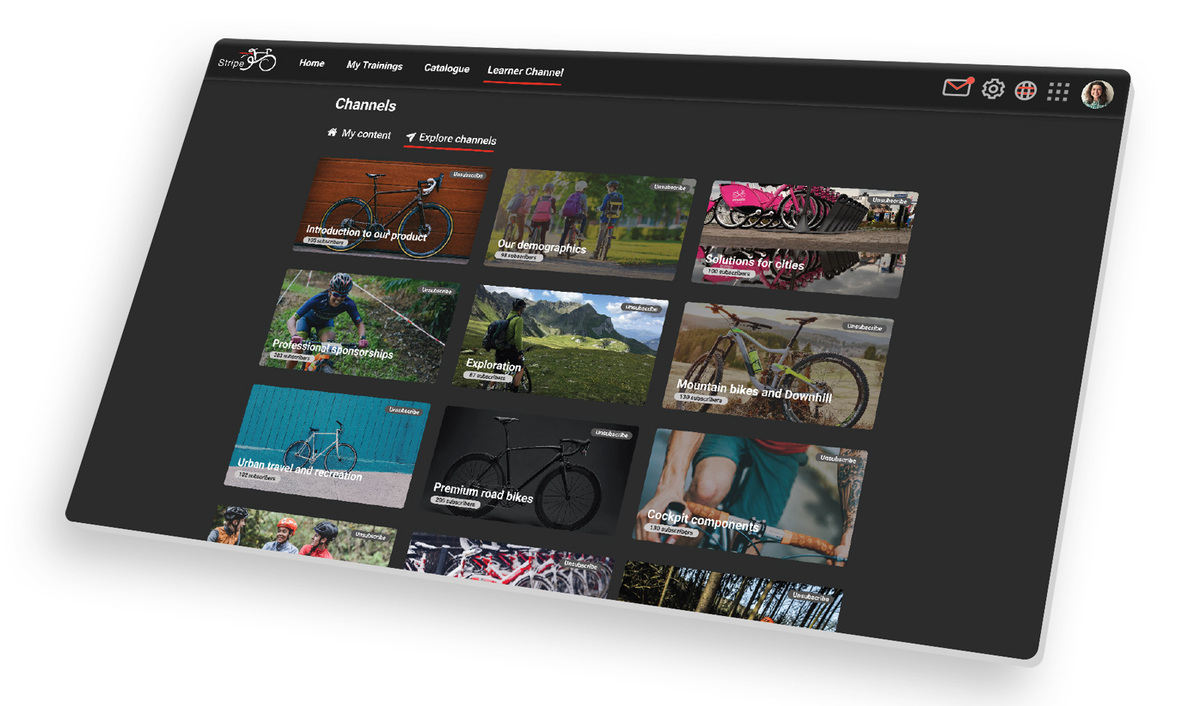
Users receive notifications whenever new content is added to the topics to which they have subscribed. Marion Sander-Feld, Head of Product Management for imc Learning Suite, explains: “Channels are topic-based containers. They are represented on screen by tiles and can contain various didactic learning nuggets, such as videos, links or PDFs. The scope is not limited to highly professional and expensive-to-produce training courses.
This is intentional, because we also want the channels to provide content that can be produced quickly in order to meet urgent learning needs. In providing this new feature, we also want to enhance the learning experience because making it faster and more intuitive to navigate the LMS and find the desired content significantly improves learning outcomes.”
By expanding the learning offering beyond the usual highly polished web-based training sessions and enabling all users to post their own learning content, channels will make learning a more bottom-up and accessible experience for all. This addition of user-generated content, which all subject experts will be able to create with ease, will help to reduce knowledge loss.
Limitations of self-directed learning
So far, so good. But as is so often the case, self-directed learning is not necessarily the one and only solution that’s needed. There will always be content that employees are loath to engage with – courses on data protection, compliance or IT security, for example.
These are extremely important topics that require not just learning, but genuine internalisation, so it’s best not to leave that entirely to voluntary self-selection. But even with compulsory training like this, the managers responsible should still apply the problem-based strategies of self-directed learning.
Thus, if the topic is cyber security, the content should present concrete examples and real-life problem scenarios that show employees how they can help prevent cyberattacks. And if this approach works with less-than-popular courses, it is sure to be a major success when it comes to self-selected content. Because learning should be like watching Netflix: child’s play.

Diary of an LMS
If an LMS wrote a diary - what would it say?
We thought about that and share some tips for LMS professionals, told a little differently...

Informal learning: Everyday hero of work
“Formal learning is like riding a bus. Informal learning is more like cycling.” We explain what this means and share some key facts and recomemndations

More about our LMS
If you would like to learn more about imc's Learning Management, check here for more information.

Contact person
I have been working in the Marketing & Communication Team at imc since March 2019.
Communication, creative content and social media are my passion. "KISS - Keep it short and simple" is my credo.
To explain complex content in an understandable way and thus make the topic of e-Learning accessible to everyone is an exciting challenge every day.
Privately I love to read, play poker and travel a lot.
I am always happy to receive feedback or suggestions.


